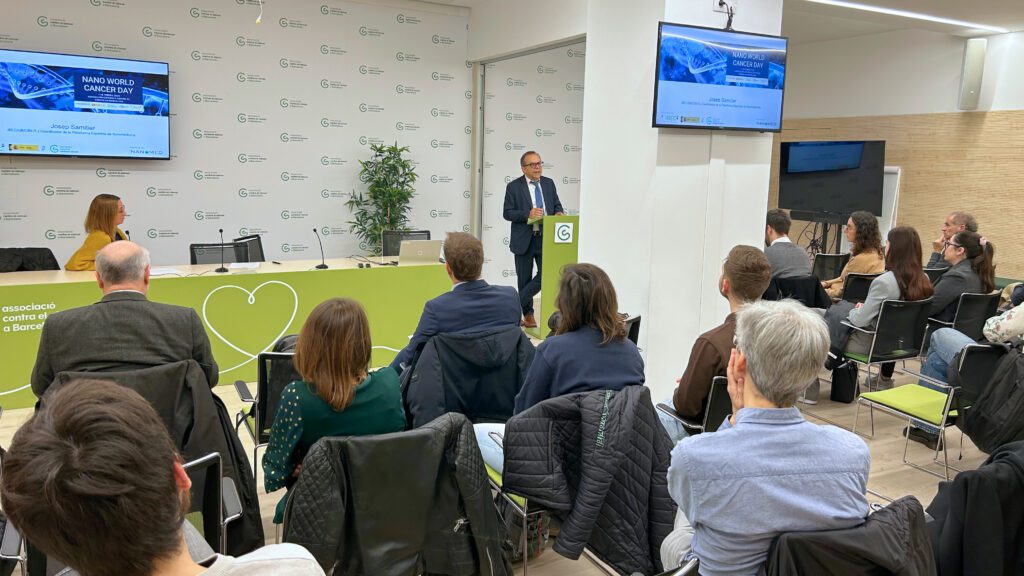Once again, experts in nanomedicine from various fields gathered in Barcelona on the occasion of World Cancer Day. The meeting provided an opportunity to showcase the latest innovations in nanomedicine for combating cancer, covering topics such as early diagnosis, controlled drug release, and radiotherapy employing nanoparticles.

Once again this year, experts in nanomedicine from various fields gathered on the occasion of World Cancer Day. This year’s edition took place at the headquarters of the Spanish Association Against Cancer in Barcelona.
The Nano World Cancer Day is an event organized by the NANOMED Spain platform, coordinated by IBEC, in collaboration with the Spanish Association Against Cancer. The meeting provided an opportunity to present the latest innovations in nanomedicine for combating cancer.
Josep Samitier, director of IBEC and scientific coordinator of NANOMED Spain and Ángela Sánchez, Managing Director of the Spanish Association Against Cancer in Barcelona welcomed the attendees. Josep Samitier emphasizing that “collaboration between public and private institutions is essential for the production, incorporation, and delivery of scientific discoveries and new drugs to patients, thereby facilitating advancements in medicine.” Additionally, he inaugurated the series of talks, focusing on nanomedicine and cancer.

Next, it was the turn of Pilar Rivera from the Universitat Pompeu Fabra, who presented NanoTarg, a tool for the diagnosis and treatment of ductal carcinoma of the pancreas, one of the most prevalent types of pancreatic cancer. Specifically, the research project aims to develop nanomedicine that encapsulates a chemotherapeutic drug for the treatment of this particular cancer.
The next talk was given by Samuel Sánchez, ICREA research professor and principal investigator at IBEC, where he shared his knowledge and extensive experience in the field of nanorobot research and its potential application in cancer treatment. He highlighted a recent research he led, where they designed urea-powered nanorobots that managed to reduce the size of bladder tumors in mice by 90%. In addition, he addressed the challenging but vital step of bringing innovations from research to clinical practice, sharing his valuable perspective from his experience as scientific director and founder of Nanobots Therapeutics, a spin-off of IBEC and ICREA.
After a short coffee break, Toni Pérez, medical director of Cebiotex, continued with the theme of the transition from the laboratory to the clinic. Pérez presented the latest innovations in nanofibers applied to cancer treatment that are being carried out at Cebiotex, a spin-off of the Universitat Politècnica de Catalunya (UPC) and the SJD Barcelona Children’s Hospital (HSJD). The company is working on the development of the drug CEB-01, which is in Clinical Phase 1, with the aim of addressing unmet medical needs in oncology and assuring surgeons and patients that the operated area has been free of cancer cells.
Rosario María Sánchez Martín, principal investigator at the GENYO Research Center of the University of Granada, spoke about NanoCARE 2.0, a nanomedicine research network aimed at advancing the diagnosis and treatment of diseases with a high social impact, such as cancer, atherosclerosis, or infections.

The conference concluded with the participation of Javier García, representative of the Spanish Association Against Cancer Scientific Foundation, who highlighted the importance of the support of the Spanish Association Against Cancer in the promotion of innovation in nanotechnology against cancer.
The symposium elucidates the advancements that nanomedicine brings to the field of health, opening up new opportunities in the diagnosis and treatment of cancer. It also underscores the significance of collaboration among various stakeholders, including researchers, entrepreneurs, medical oncologists, patients, etc., and how their collective efforts can contribute to enhancing the five-year survival rates following the onset of cancer.





